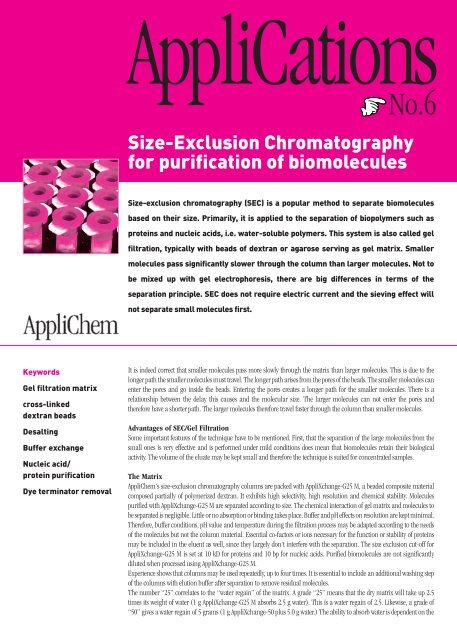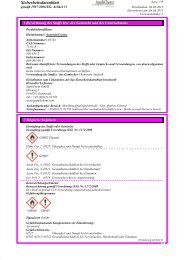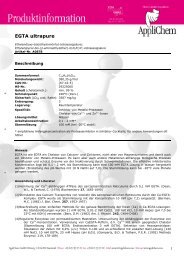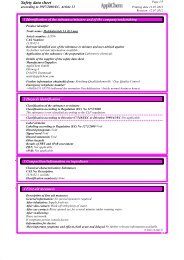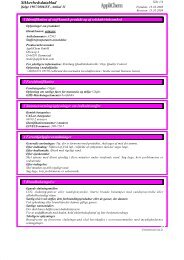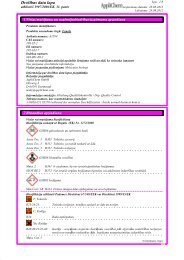Size-Exclusion Chromatography for purification of ... - AppliChem
Size-Exclusion Chromatography for purification of ... - AppliChem
Size-Exclusion Chromatography for purification of ... - AppliChem
Create successful ePaper yourself
Turn your PDF publications into a flip-book with our unique Google optimized e-Paper software.
Keywords<br />
Gel filtration matrix<br />
cross-linked<br />
dextran beads<br />
Desalting<br />
Buffer exchange<br />
Nucleic acid/<br />
protein <strong>purification</strong><br />
Dye terminator removal<br />
AppliCations<br />
<strong>Size</strong>-exclusion chromatography (SEC) is a popular method to separate biomolecules<br />
based on their size. Primarily, it is applied to the separation <strong>of</strong> biopolymers such as<br />
proteins and nucleic acids, i.e. water-soluble polymers. This system is also called gel<br />
filtration, typically with beads <strong>of</strong> dextran or agarose serving as gel matrix. Smaller<br />
molecules pass significantly slower through the column than larger molecules. Not to<br />
be mixed up with gel electrophoresis, there are big differences in terms <strong>of</strong> the<br />
separation principle. SEC does not require electric current and the sieving effect will<br />
not separate small molecules first.<br />
No.6<br />
<strong>Size</strong>-<strong>Exclusion</strong> <strong>Chromatography</strong><br />
<strong>for</strong> <strong>purification</strong> <strong>of</strong> biomolecules<br />
It is indeed correct that smaller molecules pass more slowly through the matrix than larger molecules. This is due to the<br />
longer path the smaller molecules must travel. The longer path arises from the pores <strong>of</strong> the beads. The smaller molecules can<br />
enter the pores and go inside the beads. Entering the pores creates a longer path <strong>for</strong> the smaller molecules. There is a<br />
relationship between the delay this causes and the molecular size. The larger molecules can not enter the pores and<br />
there<strong>for</strong>e have a shorter path. The larger molecules there<strong>for</strong>e travel faster through the column than smaller molecules.<br />
Advantages <strong>of</strong> SEC/Gel Filtration<br />
Some important features <strong>of</strong> the technique have to be mentioned. First, that the separation <strong>of</strong> the large molecules from the<br />
small ones is very effective and is per<strong>for</strong>med under mild conditions does mean that biomolecules retain their biological<br />
activity. The volume <strong>of</strong> the eluate may be kept small and there<strong>for</strong>e the technique is suited <strong>for</strong> concentrated samples.<br />
The Matrix<br />
<strong>AppliChem</strong>‘s size-exclusion chromatography columns are packed with AppliXchange-G25 M, a beaded composite material<br />
composed partially <strong>of</strong> polymerized dextran. It exhibits high selectivity, high resolution and chemical stability. Molecules<br />
purified with AppliXchange-G25 M are separated according to size. The chemical interaction <strong>of</strong> gel matrix and molecules to<br />
be separated is negligible. Little or no absorption or binding takes place. Buffer and pH effects on resolution are kept minimal.<br />
There<strong>for</strong>e, buffer conditions, pH value and temperature during the filtration process may be adapted according to the needs<br />
<strong>of</strong> the molecules but not the column material. Essential co-factors or ions necessary <strong>for</strong> the function or stability <strong>of</strong> proteins<br />
may be included in the eluent as well, since they largely don‘t interfere with the separation. The size exclusion cut-<strong>of</strong>f <strong>for</strong><br />
AppliXchange-G25 M is set at 10 kD <strong>for</strong> proteins and 10 bp <strong>for</strong> nucleic acids. Purified biomolecules are not significantly<br />
diluted when processed using AppliXchange-G25 M.<br />
Experience shows that columns may be used repeatedly, up to four times. It is essential to include an additional washing step<br />
<strong>of</strong> the columns with elution buffer after separation to remove residual molecules.<br />
The number “25” correlates to the “water regain” <strong>of</strong> the matrix. A grade “25” means that the dry matrix will take up 2.5<br />
times its weight <strong>of</strong> water (1 g AppliXchange-G25 M absorbs 2.5 g water). This is a water regain <strong>of</strong> 2.5. Likewise, a grade <strong>of</strong><br />
“50” gives a water regain <strong>of</strong> 5 grams (1 g AppliXchange-50 plus 5.0 g water.) The ability to absorb water is dependent on the
extent <strong>of</strong> cross-linking. Tighter cross-linking limits the ability <strong>of</strong> the beads to swell<br />
and as a consequence the water regain is lower. Less cross-linking gives a more<br />
flexible bead and allows additional swelling. The extent <strong>of</strong> cross-linking has been<br />
optimized <strong>for</strong> a particular water regain. The water regain/extent <strong>of</strong> cross-linking<br />
affects the separation properties <strong>of</strong> the gels. Larger water regain/less cross-linking<br />
results in larger pores, which in turn retains larger molecules. Less water regain/<br />
more cross-linking results in smaller pores, which in turn retains only the smallest<br />
molecules. The separation efficiency is ultimately dependent on the AppliXchange<br />
grade, flow rate, column diameter, column length, buffer eluent and size difference<br />
<strong>of</strong> the sample components.<br />
The superfine, fine, medium and coarse designations describe the average size <strong>of</strong><br />
a fraction <strong>of</strong> bead diameters. Superfine refers to 20 – 50 µm diameters, fine 20 – 80<br />
µm, medium 50 – 150 µm, coarse 150 – 200 µm, where 80 % <strong>of</strong> the fraction is<br />
within the given diameter range. The average diameter distribution affects the<br />
flow rate through the medium. Typically, plates use superfine, spin columns use<br />
superfine or fine, smaller gravity columns use medium and larger columns use<br />
medium or coarse.<br />
DextraSEC NA10 and DextraSEC PRO10<br />
“NA” stands <strong>for</strong> nucleic acids, “PRO” <strong>for</strong> protein. The number “10” correlates to<br />
the volume <strong>of</strong> the sample to be processed, i.e. columns are <strong>for</strong> the <strong>purification</strong> <strong>of</strong><br />
1.0 ml nucleic acid / protein sample. Typically, oligonucleotides are purified from<br />
salts, ammonia, and other small molecules. For example, after a labeling reaction<br />
with biotin or a dye, the excess biotin or dye is removed by using this column. The<br />
oligonucleotide size should be 10 bp or more to obtain satisfactory recovery.<br />
Comparably, proteins may be desalted or purified from dye. The protein size<br />
should be 10 kD or more to obtain satisfactory recovery.<br />
The DextraSEC products are available both in column or plate (96- or 384-well<br />
plates) <strong>for</strong>mats.<br />
Stability <strong>of</strong> the Matrix<br />
The issue is one <strong>of</strong> unwanted microbiological growth and not a physical problem<br />
associated with the AppliXchange. The hydrated matrix may be stored at room<br />
temperature indefinitely when hydrated in the presence <strong>of</strong> a preservative, such as<br />
sodium azide, thimerosal, or other commercially available biocides. We use<br />
Proclin ® 300.<br />
If the AppliXchange matrix is hydrated with water, or worse, in PBS without a<br />
preservative, significant and visible bacterial or fungal growth will eventually be<br />
observed. When this will occur depends on the conditions in which the<br />
AppliXchange was hydrated, the cleanliness <strong>of</strong> the containers used, the purity <strong>of</strong><br />
the water or buffers, etc. Since these are all uncontrolled conditions, we<br />
recommend to store rehydrated AppliXchange-G25 M (without preservative) at<br />
2 to 8°C <strong>for</strong> no longer than one week.<br />
We have hydrated AppliXchange-G25 M using very clean glassware, highly purified<br />
and sterile water, and then stored at 6°C without observing any bio-growth <strong>for</strong> over<br />
6 weeks. We have also stored the same <strong>for</strong> up to 2 to 3 days (weekend) at room<br />
temperature without problems. Please note that phosphates act like fertilizers. If<br />
desired, PBS is a fine hydration and/or elution buffer. But the columns should not<br />
be stored at room temperature in PBS without preservatives!<br />
Overload<br />
“Load” can refer to either the sample volume or concentration. Too much <strong>of</strong><br />
either will overload the column and this incorrect use <strong>of</strong> the product can be<br />
corrected by simply reducing the load. Do NOT add more volume than recommended<br />
and do NOT add an “unreasonably” high concentration <strong>of</strong> impurities and/or<br />
the molecules to be purified. This will lead to a less than satisfactory <strong>purification</strong>.<br />
If there is an exact, definable application, then we may provide a maximum<br />
allowed concentration and sample volume on request. Without this, you may<br />
have to determine your own parameters <strong>for</strong> your particular application.<br />
Instructions <strong>for</strong> Hydration (Bulk)<br />
AppliXchange-G25 M is provided as a dry powder. Be<strong>for</strong>e use, it must be hydrated.<br />
Do not stir the hydrating AppliXchange excessively during hydration, as this will<br />
damage the beads. Do not use magnetic stirrers.<br />
AppliXchange-G25 M medium will swell to a volume <strong>of</strong> approximately 5 ml <strong>for</strong><br />
every one gram <strong>of</strong> dry AppliXchange-G25 M. As a general rule, use 6.5 to 10 ml<br />
hydration buffer or water <strong>for</strong> every gram AppliXchange-G25 M that is to be<br />
hydrated.<br />
Choose the bed volume required <strong>for</strong> your application, determine the number<br />
<strong>of</strong> grams <strong>of</strong> AppliXchange-G25 M required and then determine the volume <strong>of</strong><br />
hydration buffer or water required.<br />
Hydrate AppliXchange-G25 M at room temperature <strong>for</strong> 3 hours or at 90°C <strong>for</strong><br />
1 hour. Hydrated AppliXchange-G25 M may be sterilized at neutral pH by<br />
autoclaving <strong>for</strong> 30 minutes at 120°C. For best results, the hydrated slurry should<br />
be degassed be<strong>for</strong>e use.<br />
For re-use, the hydrated gel can be washed with 2 column-volumes <strong>of</strong> 0.2 M NaOH,<br />
rinsed with 2 column-volumes water, and re-equilibrated with 2 – 3 column<br />
volumes <strong>of</strong> buffer.<br />
For storage, antimicrobial agents should be added to the suspension to prevent<br />
contamination (0.001 % phenyl mercuric salts, 0.005 % thimerosal, 0.05 %<br />
chlorobutanol, 0.002 % chlorhexine, 0.02 % sodium azide, or 20 % ethanol are<br />
acceptable). Hydrated AppliXchange-G25 may be stored at room temperature<br />
(preservative included!) or at +2 to +4°C. Do not freeze! Allow the gel to<br />
equilibrate to room temperature be<strong>for</strong>e use.<br />
Instructions <strong>for</strong> Column Handling<br />
1. Column Preparation<br />
Remove the red cap from the top and then the bottom cap <strong>of</strong><br />
the DextraSEC NA10 Column. Allow excess column fluid<br />
to drain (via gravity) into a suitable waste reservoir.<br />
2. Column Equilibration<br />
Choose a buffer <strong>for</strong> your specific application and use this<br />
same buffer <strong>for</strong> both equilibration and elution steps. To<br />
equilibrate the column, allow the equilibration buffer to<br />
enter the gel bed completely and continue elution until<br />
approximately 15 ml <strong>of</strong> buffer has been eluted.<br />
3. Sample Application<br />
Transfer up to 1 ml <strong>of</strong> your sample to the DextraSEC NA10<br />
Column. Allow the sample to enter the gel bed completely.<br />
If the sample volume is less than 1 ml, add enough equilibration<br />
buffer so that the combined volume equals 1 ml<br />
be<strong>for</strong>e applying it to the column.<br />
4. Elution<br />
Place a tube <strong>for</strong> sample collection under the DextraSEC<br />
NA10 Column. Transfer 1.5 ml <strong>of</strong> elution buffer to the<br />
column and elute the cleaned sample.
Protein Purification<br />
Absorption<br />
Absorption<br />
0,0 1,0 2,0 3,0 4,0 5,0 6,0 7,0<br />
Elution volume [ml]<br />
0,0 1,0 2,0 3,0 4,0 5,0 6,0 7,0<br />
Elution volume [ml]<br />
Removal <strong>of</strong> FITC from IgG<br />
IgG (280 nm): black line FITC (490 nm): pink line<br />
Conductivity<br />
1 mg IgG anti-Rabbit and 0.1 µmol FITC in 1 ml DMSO/NaHCO 3. Removal <strong>of</strong> excess FITC<br />
after coupling reaction. Elution with PBS.<br />
Absorption<br />
Protein Desalting from 0.8 M NaCl<br />
Protein (280 nm): black line NaCl (µS): pink line<br />
1 mg IgG anti-Rabbit in 1 ml 0.8 M sodium chloride. Elution with pure water.<br />
0,0 0,5 1,0 1,5 2,0 2,5 3,0 3,5 4,0<br />
Elution volume [ml]<br />
Removal <strong>of</strong> ammonia (33 % NH 3) from Dextran Blue<br />
Dextran Blue (620 nm): black line NH3 (pH): pink line<br />
0.5 mg Dextran Blue (Mr 2,000,000) in 1 ml ammonia (33 %). Elution with pure water.<br />
14<br />
13<br />
12<br />
11<br />
10<br />
9<br />
8<br />
7<br />
pH<br />
Oligonucleotide Purification<br />
Absorption<br />
Absorption<br />
0,0 1,0 2,0 3,0 4,0 5,0 6,0 7,0<br />
Elution volume [ml]<br />
0,0 1,0 2,0 3,0 4,0 5,0 6,0 7,0<br />
Elution volume [ml]<br />
1,00<br />
Absorption<br />
Oligo Desalting from 0.8 M NaCl<br />
Oligo (260 nm): black line NaCl (µS): pink line<br />
1 mg oligonucleotide (18-mer) in 1 ml 0.8 M sodium chloride.<br />
Removal <strong>of</strong> Rhodamine from Oligonucleotide Labelling<br />
Oligo (260 nm): black line TAMRA (550 nm): pink line<br />
1 mg oligonucleotide (18-mer) and 0.5 µmol TAMRA in 1 ml DMSO/NaHCO 3.<br />
Removal <strong>of</strong> excess TAMRA after coupling reaction.<br />
0,0 0,5 1,0 1,5 2,0 2,5 3,0 3,5 4,0<br />
Elution volume [ml]<br />
Removal <strong>of</strong> ammonia (33 % NH 3) from Nucleic acid<br />
Oligo (260 nm): black line NH3 (pH): pink line<br />
1 mg oligonucleotide (18-mer) in 1 ml ammonia (33 %)<br />
after cleavage from solid support and protection group removal.<br />
9<br />
8<br />
Conductivity<br />
14<br />
13<br />
12<br />
11<br />
pH<br />
10
A95,E<br />
Typical Analytical Data <strong>of</strong> AppliXchange-G25 M<br />
(Product No. A8507)<br />
CAS Number 9041-35-4<br />
HS No. 39139000990<br />
Appearance white solid<br />
Fractionation range (globular proteins) – Mr 1000 – 5000<br />
Fractionation range (dextrans) – Mr 100 – 5000<br />
Bead structure Cross-linked dextran composite<br />
Bead size (Dry Particle <strong>Size</strong>) 50 – 150 µm<br />
Bead size (Wet) 85 – 260 µm<br />
Bed Volume in Water 4 – 6 ml/g<br />
Maximum operating pressure Obeys Darcy’s Law<br />
Chemical stability All commonly used buffers, including:<br />
0.2 M NaOH; 0.2 M HCl; 1 M Acetic acid;<br />
8 M Urea; 6 M Guanidine HCl; 1 % SDS,<br />
24 % Ethanol; 30 % Propanol;<br />
30 % Acetonitrile.<br />
pH stability 2.0 to 13.0,<br />
Autoclavable at 121°C, pH 7 <strong>for</strong> 30 minutes<br />
Storage ambient (Do not freeze!)<br />
High Per<strong>for</strong>mance Results: • Over 90 % recovery<br />
• Easy-to-use<br />
• High chemical stability<br />
• High resolution<br />
Description Product No. Quantity Sample Volume<br />
DextraSEC NA10 A8870,0050 50 Columns 0.5 – 1 ml<br />
DextraSEC PRO10 A8822,0050 50 Columns 0.5 – 1 ml<br />
DextraSEC 96W A8595,0296 2 Plates max. 15 µl/well*<br />
DextraSEC 96W A8595,2596 25 Plates max. 15 µl/well*<br />
DextraSEC NA2 A8590,0050 50 Columns 0.15 – 0.25 ml<br />
DextraSEC PRO2 A8710,0050 50 Columns 0.15 – 0.25 ml<br />
coming soon: DextraSEC 384W 384-Well Gel Filtration Plates<br />
<strong>for</strong> sample volumes <strong>of</strong> max. 10 µl<br />
*Main application: dye terminator removal in automated DNA sequencing procedures<br />
01/2010<br />
<strong>AppliChem</strong> GmbH | Ottoweg 4 | D-64291 Darmstadt | Phone +49 6151 93 57-0 | Fax +49 6151 93 57-11 |<br />
eMail service@applichem.com | Internet www.applichem.com 4t Matthes + Traut · Darmstadt


